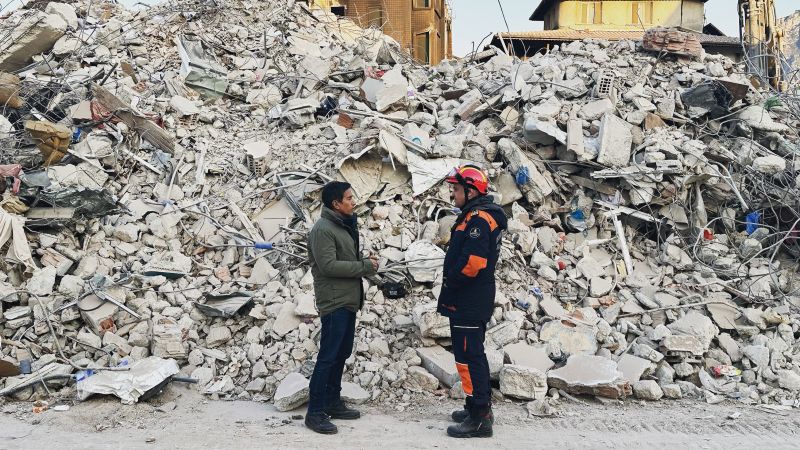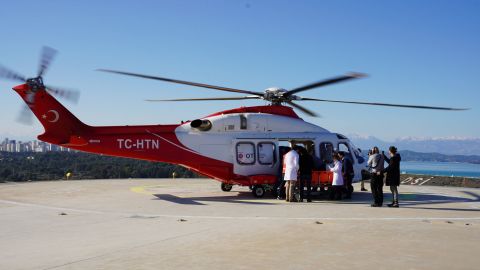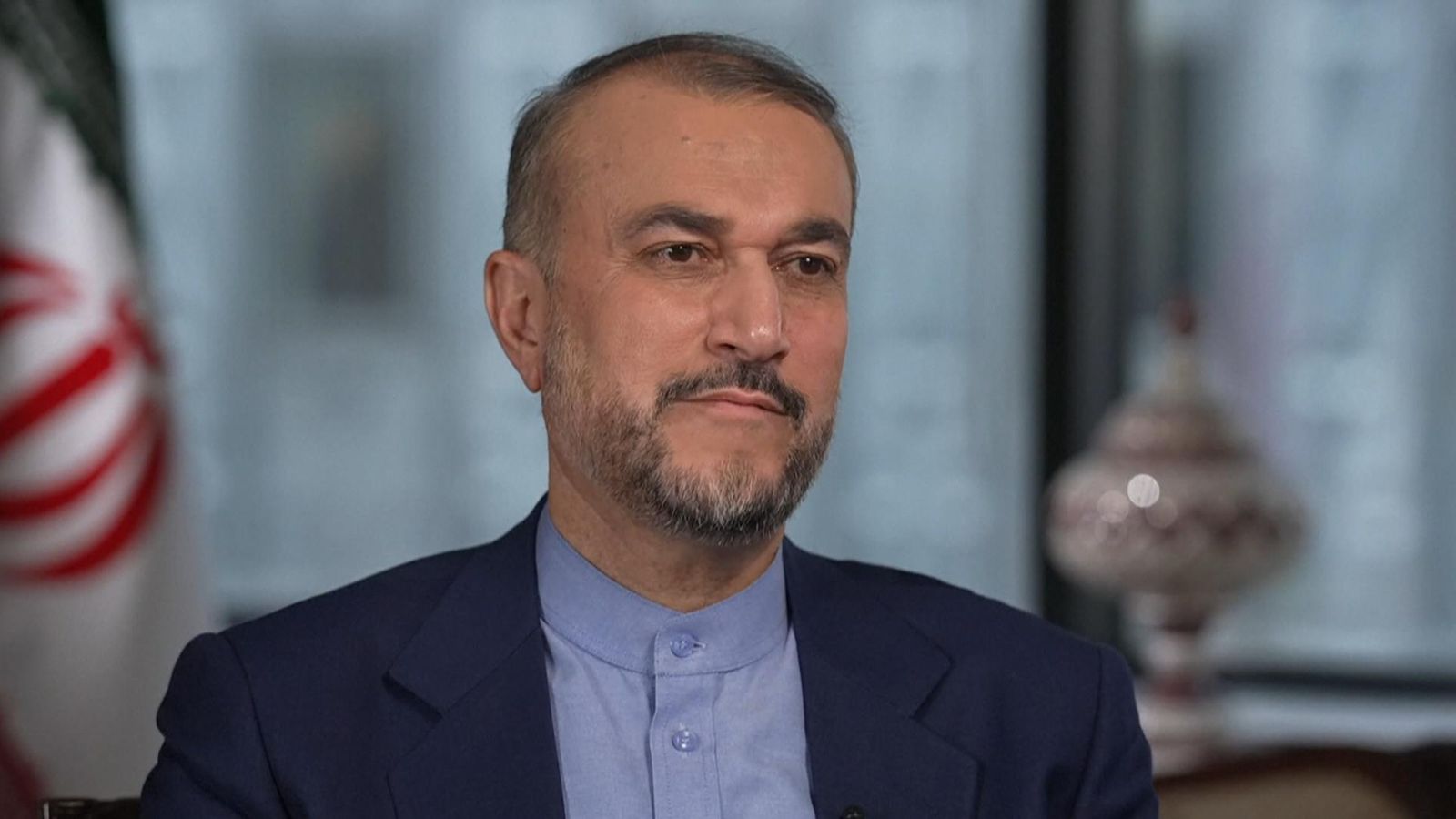How ‘extraordinary’ survivors are still being pulled from rubble 10 days after massive earthquake | CNN

CNN
—
More than 10 days after the devastating 7.8 magnitude earthquake that hit Turkey and Syria, people continue to be pulled from the rubble alive, defying expectations for survival after so many hours.
“We, of course, thought this wouldn’t be possible, because getting somebody out alive after 10 days would’ve been a really great surprise for us,” rescue worker Özer Aydinli told CNN Chief Medical Correspondent Dr. Sanjay Gupta this week.
Aydinli and his team rescued a 13-year-old boy named Mustafa from the rubble 228 hours – nearly 10 days – after the quake.
“When [our friends] said, ‘We found a person alive,’ we thought, ‘No, they must be hallucinating.’ We couldn’t believe it. But it is a miracle. … The only thing we can say is that this is a great miracle,” he said.
Search and rescue teachings have historically emphasized the “golden 48 hours” after a building collapse in which the chance of live rescues is highest. Some studies say the majority of live rescues happen within the first five or six days.
However, people continue to be rescued alive from the rubble of the February 6 quake, including Mustafa.
“I have no clue how he survived for 228 hours, because as the excavator was in operation, there was more debris falling around, filling the space above and under him, and so we couldn’t see any intact residential structure, because it was all rubble,” rescue worker Uğur Sevgin told Gupta. “Then, from the rubble, we got him out, digging him out by hand.”
Amid the rubble, Aydinli said, there was just a pair of eyes and then the call of “Brother!”
“When we saw it, when we heard it, there were 70, 80 people in the crew, and when we said there was a person alive, all our friends swarmed the area,” Aydinli said. “Nobody moved, and we all cried. And even now, we get tears in our eyes from time to time.”
Aydinli says Mustafa may have been trapped in the “triangle of life,” explained by a theory that when buildings collapse, ceilings fall on objects or furniture inside, leaving a viable space next to the person.
“After seeing Mustafa, I absolutely believe that there will be others. It is a miracle,” Sevgin said. “But, of course, it seems scientifically impossible. It has been 10 days and counting.”
Some rescue teams follow a “rule of fours,” which assumes that trapped people can survive four minutes without air, four days without water and four weeks without food.
However, research suggests that “rigid, universal timeframes” may be inaccurate, as survival can be extended under rare conditions.
In Turkey, for example, experts say those who were stuck in collapsed residential buildings may have had access to some source of water or food.
“You really only need a little bit of air, oxygen, water and probably a little bit of food to survive, hopefully just enough to get to a point where the rescuers can find you,” said Dr. Jarone Lee, an emergency and disaster medicine expert at Massachusetts General Hospital. “But I think it also relates to what kind of injuries happen during the initial sort of collapse and insult, if they only had a minor injury versus a major injury to the internal organs like your liver and such.”
Lee said a person’s baseline health status is key. Those with pre-existing medical conditions – who may be unable to access their medication or whose medication includes side effects such as dehydration – have a lower likelihood of survival.
“I do think that the ones that will continue to be found will be the younger, probably kids and other folks who are more robust. … Kids are usually smaller too, and there’s always a chance that they might be in an area of the collapse that they can survive longer just because they are smaller,” Lee said.
Experts say cold temperatures may prevent dehydration and heat exhaustion among trapped people, but the subfreezing temperatures in Turkey and Syria are doing more harm than good.
“In trauma patients, cold temperature is not a good thing for the physiology in general. After some degree of hypothermia, cardiac arrest can be a problem. Blood clotting factors do not work well, and other serious physiologic derangements happen,” said Dr. Girma Tefera, medical director of the American College of Surgeons’ Operation Giving Back.
Advances in search and rescue training and technologies, including the use of dogs, drones and on-site IV rehydration, may also account for the extended survival times.
Lee said that although he is hopeful there will be many more survivors, these are “extraordinary or rare circumstances” amid the more than 43,000 deaths after the earthquake. “These are in many ways still a handful of survivors in a massive amount of unfortunate devastation and death.”
Rescue is only the beginning of a survivor’s road to recovery.
At the Adana City Teaching and Research Hospital, the largest trauma hospital in the region, more than 5,000 patients were treated in the week after the earthquake.
Dr. Suleyman Cetinkunar, chief of staff at the hospital, told Gupta that the majority of injuries include “limb loss, tissue crushes and brain trauma.”
In addition to traumatic injuries from the collapse, patients may have “crush syndrome,” when compressed muscle tissues are finally freed and broken down, releasing toxins into the blood. These toxins can injure the kidneys and lead to kidney failure, causing seemingly stable patients to rapidly deteriorate after rescue.

During their interview, the team received another call to the helipad to receive a 26-year-old who had crush syndrome and was in need of immediate dialysis.
“Even just getting out of the rubble is a big step to get them stabilized into the hospital. But they are not out of the woods in any way. There’s a good chance that they still might not survive in the hospital,” said Massachusetts General’s Lee.
Receiving lifesaving medical care becomes even more difficult as hospital buildings, like most other buildings, were not spared by the earthquake.
The government and nonprofit organizations have set up field hospitals, tent hospitals and even hospital ships to continue to care for earthquake victims.
Gupta spoke to doctors who are performing essential orthopedic surgery in tents set up in the parking lot of a ruined hospital in Antakya, Hatay province.
“I’ve worked in places before where people like this don’t have the operation. They lay at home, languish. Some of them would get bedsores, blood clots, pneumonia and maybe die from that,” Dr. Greg Hellwarth, an orthopedic surgeon from Indiana, told Gupta.
Dr. Elliott Tenpenny, an ER doctor from North Carolina and director of the International Health Unit for Samaritan’s Purse, showed Gupta around the field hospital where, amid 5.0 aftershocks, they continue to manage critical conditions like blood loss and asthma.
“It’s not just about the broken bones and the crush injuries. It’s about these patients also,” Tenpenny told Gupta.
The floating hospital also provides immediate beds, operating rooms and even a maternity ward. Unlike the field hospitals on the ground, hospital ships are relatively protected from the aftershocks that continue to devastate the land, the captain told Gupta.
Experts say this disaster causes disruptions in the health care system that put people with chronic medical conditions at risk of losing access to lifesaving medications or medical appointments.
“The consequences of that are going to be in weeks to years, months to years,” Lee said. “The fallout is going to be unfortunately massive from this.”
World News || Latest News || U.S. News
Source link



